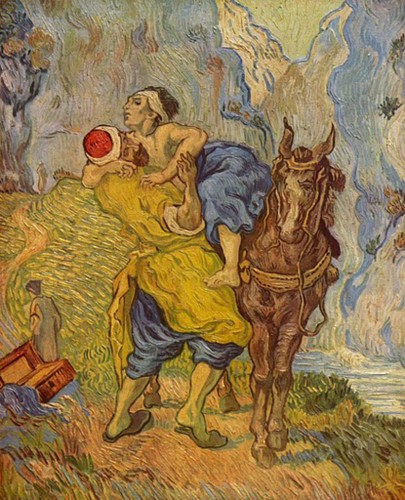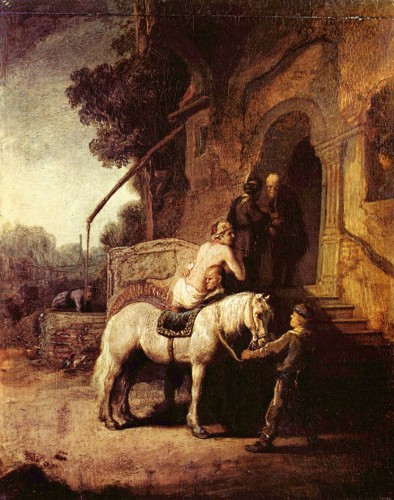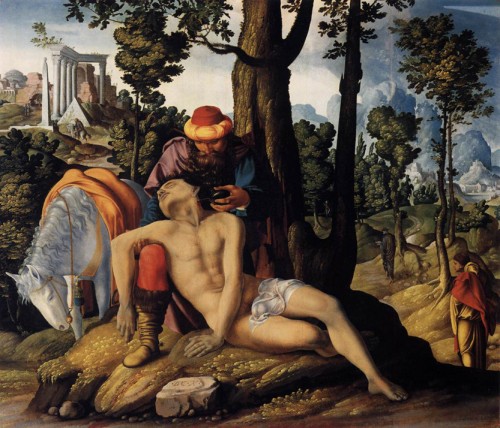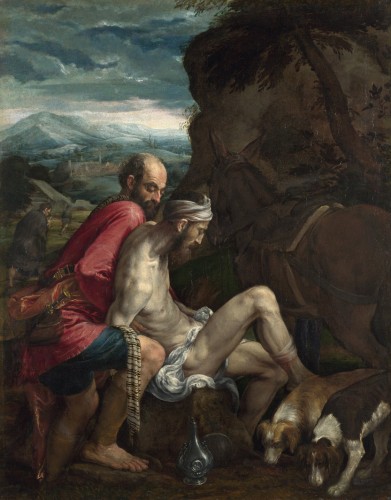 Who is my neighbor? asked the lawyer, testing Jesus in that age-old theological sport: debate. And specifically, debate over moral reasoning. You know, it isn’t only church folks who do this, we all do it, and we do it all day long, every day, every day, every day.
Who is my neighbor? asked the lawyer, testing Jesus in that age-old theological sport: debate. And specifically, debate over moral reasoning. You know, it isn’t only church folks who do this, we all do it, and we do it all day long, every day, every day, every day.
We constantly evaluate every little thing – we shoulda, coulda, woulda ourselves and each other. We cast shadows and take them away, in an instant application of this kind of measuring.
And, while we do it everywhere and to everyone, politicians, celebrities, bosses, parents and kids, it is always open season on neighbors, neighbors in the next house, or at the next desk, or in the next pew, neighbors whom we’ve known forever and neighbors who are strangers. It’s so endemic among us, it is the basic stuff of our situation comedies.
Jesus answered the lawyer with a story: A man was going down from Jerusalem to Jericho, and fell into the hands of robbers, who stripped him, beat him, and went away, leaving him half dead. Now by chance . . . .
 Jesus continues, telling of three passersby: a priest, a Levite, a Samaritan. The first two moved to the other side of the highway, avoiding the mess, the problem, the implications – and the risks. The Samaritan, moved by compassion, moved to the injured man, treated his wounds, took the man to an inn, paid for his care there.
Jesus continues, telling of three passersby: a priest, a Levite, a Samaritan. The first two moved to the other side of the highway, avoiding the mess, the problem, the implications – and the risks. The Samaritan, moved by compassion, moved to the injured man, treated his wounds, took the man to an inn, paid for his care there.
Now Jesus asks a question, and it is a test: which one was a neighbor to the man? Well, you know the answer.
And we’ve striven to organize society to be sure that such unfortunates are never neglected. We’ve created careers for First Responders, and government departments to deal with Disasters, and watchdog agencies to monitor behavior and church mission committees to get us involved where it counts. We send youth on mission trips to learn these lessons.
This week alone, I’ve read a e-conversation over many days between clergy who were struggling to grasp the meaning of charitableness, of compassion, of mercy. Many wrote of the negative associations with the Let Me Help You public attitude, that assumes a kind of moral superiority in the helper, that can foster dependence in the helped, that can generate anger over disempowerment, not to mention repugnance at the proferred help. FEMA, the disaster response agency, takes a drubbing for its responses. So do churchladies, the proverbial icon of helping. The clergy were struggling to to find a way through the thicket of all this. How can you help without hurting, was the focus of their discussion.
 But I think the discussion, for all its sincerity, missed the main point.
But I think the discussion, for all its sincerity, missed the main point.
The lawyer who questioned Jesus was asking for this kind of debate, this kind of thoughtful articulation of limits and lines, of behaviors and responsibilities, of goodness and meddling.
But Jesus has posed a situation where there isn’t time to think about it, and where the only decision to be made is whether you will let yourself be interrupted in what you were planning to do, whether you will shift your whole day, whether you will interfere with your own finances. Or not.
The Jericho road was not a country lane where folks went out for a walk, it was a highway, and everyone on it had somewhere to go and something to do, and a schedule to meet. The first two passersby, the priest and the Levite (a lawyer, in fact), were in harness to their schedules, their tasks, their appointments, their world.
The Samaritan stepped out of his day, upended his plans and commitments, and spent the money in his pocket, not on what he was planning to use it for, but for a beaten man. He didn’t stand there and weigh the merits. He acted. And he acted not to improve someone’s lifestyle, and not to mete out justice, but to help a man survive.
 So the answer to the question, who is my neighbor, which is really the question: exactly who do I have to love as much as I love myself; is turned by Jesus into a questions about the self: how good a neighbor are you? And the answer has two parts: for what stranger do you unhestitatingly interrupt yourself to offer aid? and, can you see that people you would not like to have to love (Samaritans) may be better at this than people you admire?
So the answer to the question, who is my neighbor, which is really the question: exactly who do I have to love as much as I love myself; is turned by Jesus into a questions about the self: how good a neighbor are you? And the answer has two parts: for what stranger do you unhestitatingly interrupt yourself to offer aid? and, can you see that people you would not like to have to love (Samaritans) may be better at this than people you admire?
Jesus holds up, for our loving, a stranger who has has badly treated. God knows who he is: drunk or brigand, traveling salesman, fool or innocent. All we know is, he isn’t one of us, and he needs immediate help.
In Boston, there’s been a lot of rejoicing over the response at the Marathon bombings of those who ran towards the bombed, those who saved lives and limbs by quick action and courage in a scary situation. Indeed, this was wonderful! We also know there were those who ran the other way, terrified and reacting in fear – and they might have been me, had I been there. I just don’t know how I would respond to bombs. But Jesus isn’t pressing us to brave bombs in this story, instead he is asking us to have the courage to interrupt our lives and move into Plan B. After all, most of life is Plan B, if we are honest. Maybe even, you know, Plan R. Days, lives, family, dreams, all require us to let go of Plan A, in order to move on, move in, move toward, move with.
 Jesus, whose glorious blessing in the river Jordan took him to an inglorious cross on Calvary, understood a lot about interruptions and revisions in plans. He emphasized the need to trust in the kindness of strangers, and to become generous to strangers. He asked us to love strangers, for God’s sake, as if they were ourselves, our neighbors.
Jesus, whose glorious blessing in the river Jordan took him to an inglorious cross on Calvary, understood a lot about interruptions and revisions in plans. He emphasized the need to trust in the kindness of strangers, and to become generous to strangers. He asked us to love strangers, for God’s sake, as if they were ourselves, our neighbors.
The Letter to the Hebrews urges us to be kind to strangers, for thereby some have entertained angels unawares.
And there is an ancient Scots Celtic prayer:
I saw a stranger yesterday.
I put food in the eating place,
drink in the drinking place,
music in the listening place.
And the stranger blessed me,
my house, my cattle and my dear ones.
Ah, as the lark says in her song,
often, often, often, goes the Christ
in a stranger’s guise.
_______________________________________________
Illustrations:
1. Good Samaritan, by Vincent van Gogh, 1890, Otterlo, Netherlands. Vanderbilt Divinity School Library Collection, Art in the Christian Tradition.
2. Good Samaritan, by Rembrandt von Rijn, 1630, London, Wallace Collection. Vanderbilt Divinity School Library Collection, Art in the Christian Tradition.
3. Good Samaritan Window, 1882, Trinity Church, Boston, MA. Vanderbilt Divinity School Library Collection, Art in the Christian Tradition.
4. Good Samaritan, Unknown Artist, 1537, Rijksmuseum, Amsterdam, Netherlands. Vanderbilt Divinity School Library Collection, Art in the Christian Tradition.
5. Good Samaritan, by Jacopo Bassano, 1518- 1592, London, National Gallery.
Vanderbilt Divinity School Library Collection, Art in the Christian Tradition.
The Scots Celtic prayer is from The Carmina Gadelica, collected by Andrew Carmichael.











